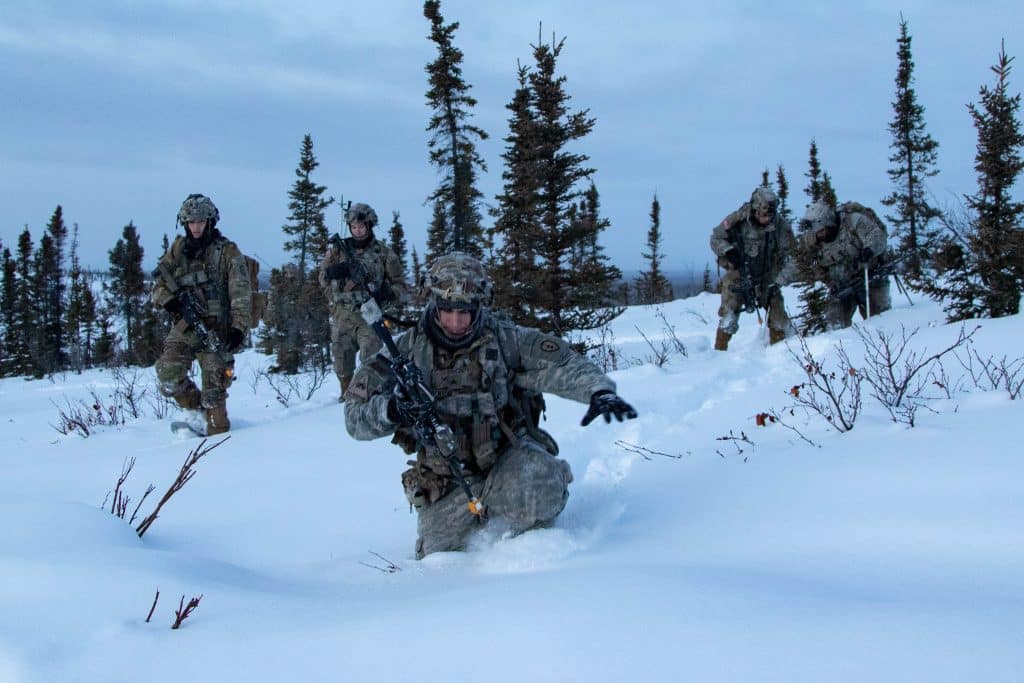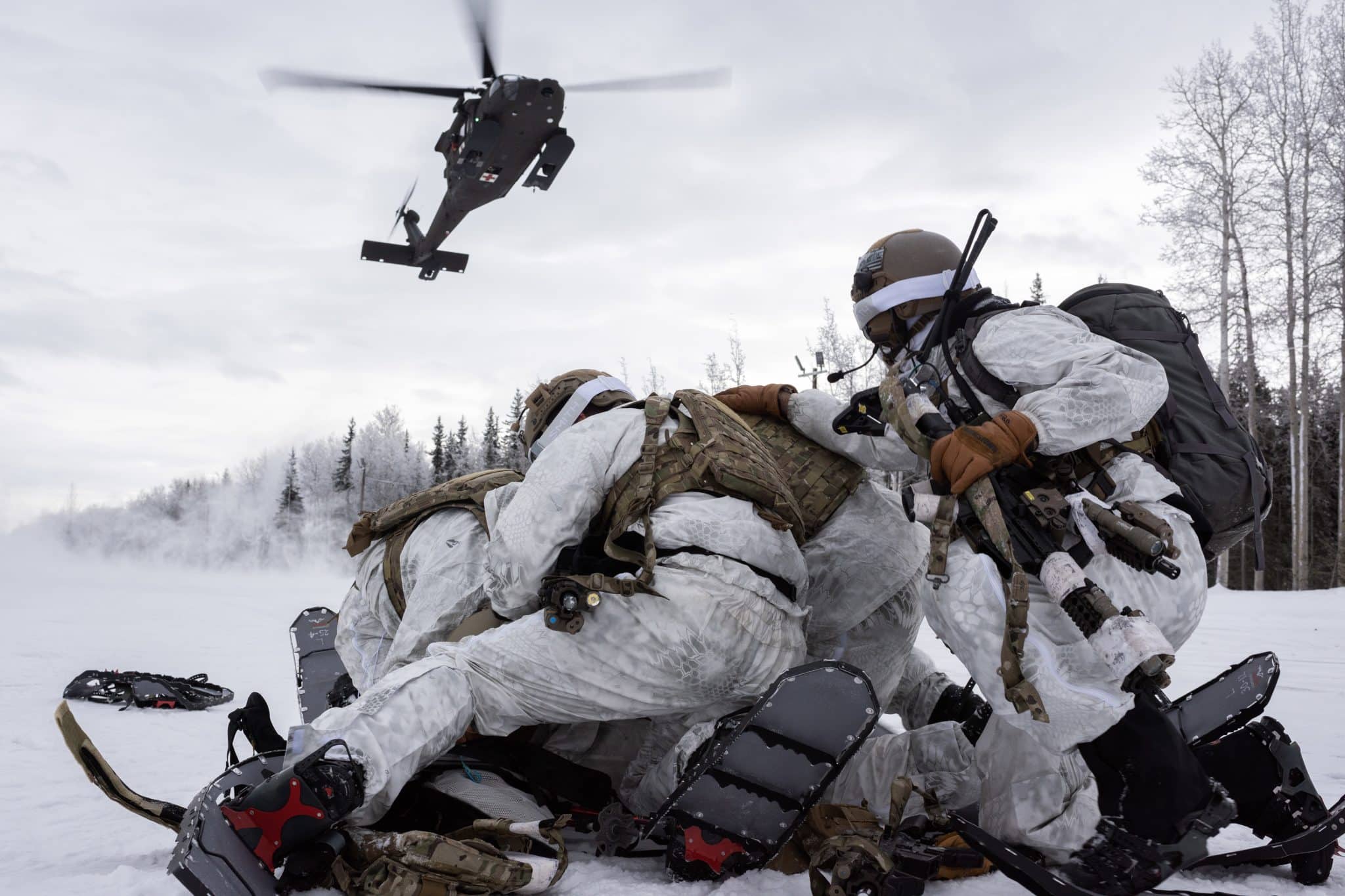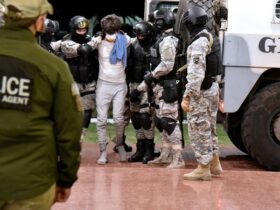by MSG Daniel L. Dodds, US Army
In the wake of Russia’s invasion of Ukraine and the instability of Russian President Vladimir Putin, the Arctic region can no longer be an afterthought for the United States (U.S.) National Security Strategy. The U.S. is one of eight nations with landmasses in the Arctic region, along with Canada, Denmark, Finland, Iceland, Norway, Sweden, and Russia (U.S. Department of State, n.d.a). According to the U.S. Army Chief of Staff, General James McConville, the mission of the Army is to fight and win our nation’s wars against any adversary, anywhere, at any time (Army.mil, n.d.) Inherent to this task, the Army must execute its Title 10 functions of manning, training, equipping, and organizing to dominate in the Arctic region (Department of the Army [DA], 2021). The lack of U.S. military presence in the Arctic region jeopardizes U.S. national interests and requires the realignment of the Arctic region under the command and control of U.S. Northern Command.
Background of the Arctic Region
Three decades after the Cold War, the Arctic is thrusting into focus once again and becoming a source of great power competition (Soare, 2020). The acceleration of climate change and diminishing Arctic ice is bringing unprecedented change to the region’s 30 years of cooperation (O’Rourke et al., 2022). The Arctic has a significant quantity of fisheries and animals, oil, and gas, both on and offshore. Additionally, researchers estimate $1 trillion worth of precious metals and minerals in the Arctic (O’Rourke et al., 2022). Melting Arctic ice is making the Northern Sea Routes, known as the Northeast Passage, Northwest Passage, and Transpolar Passage, more accessible for commercial shipping and tourism (Soare, 2020). Russia is claiming the Arctic region as theirs and is looking to control access to the region as well as its untapped resources. In one instance, Russian Foreign Minister Sergei Lavrov stated “We hear whining about Russia expanding its military activities in the Arctic. But everyone knows that it’s our territory, our land” (Auerswald, 2021, para. 2). Russia’s persistence in controlling the Arctic region is a significant cause for concern and a crucial factor in the weakened U.S.-Russian relations.
Background of U.S.-Russian Relations
The U.S. bought Alaska from Russia on 30 March 1867 with the formal transferal of the Alaskan territory occurring on 18 October 1867 (U.S. Department of State, n.d.b). The purchase granted the U.S. unfettered access to the Pacific northern rim and Arctic region. Approximately 80 years later, U.S. and Russian relations soured due to the opening of the Truman Doctrine in 1947 and lasted until the disbandment of the Soviet Union in 1991, which was the Cold War era (Council on Foreign Relations [CFR], 2022). From 1992 to 2007, relations improved and both countries agreed on economic aid, space collaboration, the Moscow declaration of ending nuclear missiles aimed at each other, and the Open Skies treaty enabling both countries to fly over one another (CFR, 2022). However, relations were strained once again when the U.S. and the North Atlantic Treaty Organization (NATO) agreed to place the European Ballistic Missile Defense System in Poland as Russia perceived this as a direct threat to their sovereignty (CFR, 2022).
From 2009 to 2011, U.S. and Russia strengthened relations by signing the New Strategic Arms Reduction (New-START) treaty which “commits Washington and Moscow to another round of cuts to their strategic offensive arsenals” (CFR, 2022, para. 24). In 2014 Russia invaded Crimea resulting in the annexation of the ethnic Russian-majority region of Ukraine’s territory and economic sanctions from the west which reinvigorated the U.S.-Russian rivalry (CFR, 2022). As a result, the U.S. withdrew from the Intermediate-Range Nuclear Forces (INF) treaty, the Open Skies treaty, and bilateral agreements between both countries (Burgos, 2019). Russia’s most recent invasion of Ukraine resulted in severe sanctions from the global community, seizing worldwide assets of oligarchs and parliamentary members, weakening their economy, and putting relations at an all-time low (Welt, 2022). Russia’s provocations with the West and their impulsive rhetoric in the Arctic and around the world is a focal point that creates the problem that exists today.
Problem
There are two critical problems for the U.S. in the Arctic region. First, global warming induced melting sea ice and thawing permafrost has enabled new shipping routes, created a race for untapped resources, and a desire for Russia to control the Arctic region (White House, 2022). Second, Russia’s militarization of the region is a direct threat to U.S. national interest and homeland (White House, 2022). Compounding this problem is the fact that the Arctic region nests between three geographic combatant commands, European Command, Indo-Pacific Command, and Northern Command, and has no clear command to synchronize efforts (DA, 2021; Greenhaw et al., 2021). Over the last decade, Russia has tried to exert control over the Arctic region as they continually fly through the Alaskan Air Defense Identification Zone (ADIZ) and conduct military drills in the Arctic region to assert dominance (Auerswald, 2021). Recently, Russia conducted three simultaneous breaches of polar ice with their submarine fleet which has the capacity for each of them to deploy 16 ballistic missiles capable of striking anywhere in the U.S. with a nuclear warhead (Auerswald, 2021). Realigning the Arctic region under U.S. Northern Command (USNORTHCOM) is the solution for the provocations from Russia and a crucial link for protecting the homeland.

Solution
According to the White House (2022), the strategic pillars for National Security of the Arctic region are security, environmental protection, sustainable economic development, and international cooperation and governance. These pillars supply the foundation for developing a comprehensive solution that protects U.S. national interests in the Arctic. Through realignment of the Arctic region under USNORTHCOM, the Arctic will have a regional military focus and a clearly defined geographic area. Bringing this solution to fruition requires “materiel and non-materiel solutions across the Army’s doctrine, organization, training, materiel, leadership and education, personnel, facilities, and policy (DOTMLPF-P) domains” (U.S. Army War College [USAWC], 2021, p. 17).
Doctrine Change and Materiel Integration
The Army must change its doctrine and improve its materiel to protect U.S. national interests in the Arctic region and the homeland. During the Cold War era of the 1980s, the Army fought using air-land battle in the Arctic (U.S. Army, 2022). In preparation for a future conflict, the Army must use Multi-Domain Operations (MDO) due to the complexity of unknown battlefields. The convergence of air, land, sea, space, and cyberspace is critical to dominating in the Arctic (U.S. Army, 2022). Current equipment underperforms in Arctic conditions and requires modernization as well as new equipment fielding. Fighting in the Arctic will require long-range precision fires, updated air, and missile defense systems, and cold weather-capable vehicles that can survive the Arctic terrain.
The Army awarded BAE Systems a $278 million contract for the procurement of 10 cold weather all-terrain vehicles (Magnuson, 2022). These vehicles run in “snow, ice, rock, sand, mud, steep mountain environments … and can swim in flooded areas and coastal waters” (Magnuson, 2022, para. 6). Units operating in the Arctic region will need to transition their high mobility multipurpose wheeled vehicles (HMMWV) and M997 ambulance vehicles into these cold weather all-terrain vehicles to “operationalize” their vehicle fleet. Utilizing MDO closes capability gaps and presents adversaries, like Russia, with too many dilemmas which enable the U.S. to regain Arctic dominance. Finally, incorporating new equipment, like the cold weather all-terrain vehicle provides the U.S. with the tactical advantage to extend the fight beyond the confines of its current capabilities. Changing how the Army fights in the Arctic region and what they fight with, requires organizations like the 11th Airborne Division (ABD) to restructure.
Organization and Personnel Restructure
The Arctic region and USNORTHCOM need to restructure the 11th ABD to close the organizational capability gap in the Arctic region. Currently, the 11th ABD has two Infantry Brigade Combat Teams (IBCT), a Combat Sustainment Support Battalion (CSSB), and smaller partner units like the Band, Noncommissioned Officer Academy, and Northern Warfare Training Center (NWTC) (11th Airborne Division, n.d.). However, this is insufficient to support dominance in the Arctic. Similar Light Infantry units like the 10th Mountain Division, 25th Infantry Division, and 82nd Airborne Division have an added IBCT, a Sustainment Brigade rather than a CSSB, a Division Artillery (DIVARTY) Brigade, and a Combat Aviation Brigade (DA, 2022a; DA, 2022b; DA, 2022c). Unfortunately, the 11th ABD does not have organic aviation capabilities. The 25th Combat Aviation Brigade (CAB) supplies the 1-25th Attack Reconnaissance Battalion (ARB) while the 16th CAB supplies the 1-52nd General Support Aviation Battalion (GSAB) (U.S. Army Garrison Hawaii, 2022; DA, 2022d).
Restructuring the 11th ABD is no easy feat. Fort Drum, Fort Bliss, and Fort Stewart would need to reassign entire units from their current locations to Alaska to enhance the 11th ABD capabilities. The 10th Mountain Division would need to reassign one of its IBCT from Fort Drum to Fort Wainwright. The 1st Armored Division would need to transfer the DIVARTY from Fort Bliss to Fort Wainwright. Additionally, 3rd Infantry Division would need to move elements of their Combat Aviation Brigade to enhance the preexisting aviation units currently attached to the 11th ABD. Restructuring the 11th ABD along with the personnel requirements to do so requires knowledgeable leaders, education, and training.

Leadership, Education, and Training
It is imperative to train as we fight. Equally important is the location and timing of training. Instinctively, dominating the Arctic will require extensive cold-weather training across the joint force to replicate the Arctic environment. The NWTC in Fort Wainwright Alaska can aid with training units for Arctic conditions. The NWTC has specialty training in cold-weather orientation, basic and advanced military mountaineering, cold-weather mountain warfare, and military ski training (South, 2018). Additionally, Eielson Air Force Base in Alaska hosts the Arctic Survival Training for all branches within the Department of Defense (DOD) (DOD, 2019). The Army, as part of the joint force, must conduct training in the most extreme conditions to prepare for the Arctic fight and these locations can help.
Furthermore, the Army must use opportunities offered by other Arctic nations. The Canadian Armed Forces Arctic Training Center (CAFATC) can help with “planning, organization, coordination, conduct, and supervision of deployments and training operations in the Arctic Region during its coldest months” (Macneill, 2022, para. 3). When the Army conducts training with its sister services, allies, and partners, it improves operational reach and enhances interoperability in times of crisis. These training events are necessary for the Army’s contributions to the region and necessary to regain Arctic dominance. Finally, training with sister services and other Arctic nations maximizes facilities and costs, expands learning, and empowers unity of effort.
Facilities and Cost
Enhancing the facilities in Alaska is the only way to improve the operational reach of the 11th ABD. Alaskan bases will need new infrastructure for the proposed IBCT, DIVARTY, and aviation assets. Once complete there would be 8,000 personnel added to Fort Wainwright, Fort Greely, and Joint Base Elmendorf-Richardson. According to the Congressional Budget Office (CBO) (2021), the facilities for a new IBCT in the Arctic would cost $800 million for the headquarters of the brigade and subordinate battalions, barracks and appliances, motor pools, and storage facilities. An additional $234 million is needed in annual costs to sustain operations, training, equipment upkeep, and modernization (CBO, 2021). According to Tilghman (2015), the cost of a permanent change of station has risen 28% annually to $8,576 per person. Moving the required personnel to the Arctic would cost an additional $69 million. In total, the Army would need $1.1 billion worth of construction to enhance infrastructure in the Arctic region, modernizing the 11th ABD and fielding the presence needed for this new operational area.
Conclusion
Limited military presence in the Arctic area jeopardizes U.S. national interests and proves the need to realign the Arctic region under U.S. Northern Command. The acceleration of climate change is creating a race to control the $1 trillion worth of fisheries, oil, and gas resources in the Arctic and reinvigorating the U.S.-Russian rivalry. The relationship between U.S. and Russia is at an all-time low, and Russia’s persistent militarization of the Arctic poses a direct threat to the U.S. homeland. The only way to counter the threat is to close capability gaps by using the DOTMLPF-P framework to provide suitable, acceptable, and feasible solutions within the Army. Changes to doctrine and integrating new materiel enhance the fight in Artic conditions. Reorganizing the 11th ABD by adding an IBCT, DIVARTY, and Aviation units and personnel is necessary to operationalize the force and be able to react to crisis and conflict. Moving units to the Arctic requires added training and education, fortunately, NWTC maintains the ability to supply the necessary training. Enhancing the Arctic will have an initial cost of $1.1 billion and provide the region with the forces needed to enforce the strategic pillars for National Security of the Arctic region are met.

References
11th Airborne Division. (n.d.). 11th Division units. https://11thairbornedivision.army.mil/Units/
Army.mil. (n.d.). Who we are: The Army’s vision and strategy. https://www.army.mil/about/
Auerswald, D. (2021). A U.S. security strategy for the Arctic. War on the Rocks. https://www.whitehouse.gov/briefing-room/statements-releases/2022/10/12/fact-sheet-the-biden-harris-administrations-national-security-strategy/
Burgos, S. (2019). U.S. completes INF treaty withdrawal. Arms Control Today. https://www.armscontrol.org/act/2019-09/news/us-completes-inf-treaty-withdrawal
Congressional Budget Office. (2021). The U.S. Military’s force structure: A primer, 2021 update. https://www.cbo.gov/system/files/2021-05/57088-Force-Structure-Primer.pdf
Council on Foreign Relations. (2022). U.S.-Russia nuclear arms control. https://www.cfr.org/timeline/us-russia-nuclear-arms-control?gclid=EAIaIQobChMIieW0tbbj-gIVkjStBh3tpQITEAMYASAAEgI4UPD_BwE
Department of Defense. (2019). Report to congress: Department of Defense Arctic strategy. https://media.defense.gov/2019/Jun/06/2002141657/-1/-1/1/2019-DOD-ARCTIC-STRATEGY.PDF
Department of the Army. (2021). United States Army: Regaining artic dominance. https://www.army.mil/article/244261/army_announces_release_of_arctic_strategy
Department of the Army. (2022a). 10th Mountain Division (FY 23) [Data set]. FMS Web. https://fmsweb.fms.army.mil/protected/struct/jqchart.asp?UIC=WGKEFF&DOCST=A&FY=2023
Department of the Army. (2022b). 25th Infantry Division (FY 23) [Data set]. FMS Web. https://fmsweb.fms.army.mil/protected/struct/jqchart.asp?UIC=WALXFF&DOCST=A&FY=2023
Department of the Army. (2022c). 82nd Airborne Division (FY 23) [Data set]. FMS Web. https://fmsweb.fms.army.mil/protected/struct/jqchart.asp?UIC=WAA6FF&DOCST=A&FY=2023
Department of the Army. (2022d). 16th Combat Aviation Brigade (FY 23) [Data set]. FMS Web. https://fmsweb.fms.army.mil/protected/struct/jqchart.asp?UIC=W5AAFF&DOCST=A&FY=2023
Greenhaw, T., Magruder, D. L., Mchaty, R. H., & Sinclair, M. (2021). US Military options to enhance arctic defense. Brookings. https://www.brookings.edu/wp-content/uploads/2021/05/FP_20210520_arctic_defense.pdf
MacNeill, M. (2022). Arctic operations course addresses emerging Arctic challenges. https://www.canada.ca/en/army/news-publications/2022/03/arctic-operations-course-addresses-emerging-arctic-challenges.html
Magnuson, S. (2022). Breaking: BAE wins Army’s hotly competed cold weather vehicle contract. National Defense. https://www.nationaldefensemagazine.org/articles/2022/8/22/bae-wins-armys-hotly-competed-cold-weather-vehicle-award
O’Rourke, R., Comay, L. B., Frittelli, J., & Keating-Bitoni, C. (2022). Changes in the Arctic: Background and issues for Congress. Congressional Research Service. https://fas.org/sgp/crs/misc/R41153.pdf
Soare, S.R. (2020). Arctic stress test: Great power competition and Euro-Atlantic defence in the High North. European Union Institute for Security Studies. https://www.iss.europa.eu/content/arctic-stress-test
South, T. (2018). A new cold war: How the Army is preparing for a fight in the Arctic. Army Times. https://www.armytimes.com/news/your-army/2018/07/30/a-new-cold-war-how-the-army-is-preparing-for-a-fight-in-the-arctic/
Tilghman, A. (2015). PCS costs rising across the force, even as moves decline. Military Times. https://www.militarytimes.com/2015/09/12/pcs-costs-rising-across-the-force-even-as-moves-decline/#:~:text=Since%202001%2C%20on%20average%2C%20the,today%2C%20according%20to%20the%20report
U.S. Army. (2022). Army of 2030. https://www.army.mil/article/260799/army_of_2030
U.S. Army Garrison Hawaii. (2022). 25th Combat Aviation Brigade. https://home.army.mil/hawaii/index.php/25thID/units/25thCAB
U.S. Army War College. (2021). 2021-2022 How the Army runs: A senior leader reference handbook. https://ssi.armywarcollege.edu/2022/pubs/2021-22-how-the-army-runs/
U.S. Department of State. (n.d.a) Arctic region: Office of ocean and polar affairs. https://www.state.gov/key-topics-office-of-ocean-and-polar-affairs/arctic/#:~:text=The%20members%20of%20the%20Arctic,%2C%20and%20the%20United%20States).
U.S. Department of State. (n.d.b) Purchase of Alaska, 1867. https://history.state.gov/milestones/1866-1898/alaska-purchase
Welt, C. (2022). Russia’s 2022 invasion of Ukraine: Overview of U.S. sanctions and other responses. Congressional Research Service. https://safe.menlosecurity.com/doc/docview/viewer/docND23E1C8E5743002a0cffdec8ecdcad09e7a42de64616b73f95f1ee293044a97b2731c83546e2
White House. (2022). National security strategy. https://www.whitehouse.gov/briefing-room/statements-releases/2022/10/12/fact-sheet-the-biden-harris-administrations-national-security-strategy/
Master Sergeant Daniel L. Dodds is a Military Police Senior Noncommissioned Officer. He has served in every leadership position, from Patrolman to Antiterrorism/ Force Protection Supervisor. He is currently attending the Sergeants Major Course (Resident) Class 73 at the US Army Noncommissioned Officer Leadership Center of Excellence. His civilian education includes an Associate Degree from Excelsior University, and he is pursuing his Bachelor of Arts in Leadership and Workforce Development from the Army Command and General Staff College (CGSC).
As the Voice of the Veteran Community, The Havok Journal seeks to publish a variety of perspectives on a number of sensitive subjects. Unless specifically noted otherwise, nothing we publish is an official point of view of The Havok Journal or any part of the U.S. government.
© 2023 The Havok Journal
The Havok Journal welcomes re-posting of our original content as long as it is done in compliance with our Terms of Use.










Leave a Reply